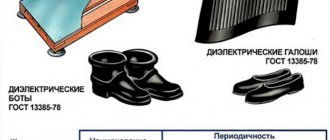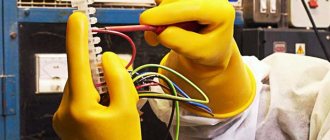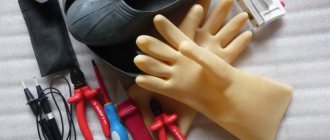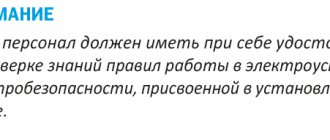How and when are periodic checks of dielectric gloves carried out? Why is it important to observe the frequency of testing gloves and what consequences can be expected if the standards established by GOST 12.4.307-2016 are neglected
You can order tests of dielectric gloves or purchase them with test reports in our electrical laboratory.
- Frequency of checking PPE against electric shock
- Test standards for dielectric gloves
- Consequences for violating the rules for checking PPE
Rubber or latex gloves are the most commonly used protective equipment when working in electrical installations. True, not all gloves made from these materials can be classified as dielectric. GOST 12.4.307-2016 specifies the parameters that gloves approved for use as the main PPE against industrial frequency electric shock with voltage up to 1000 V must meet.
Buy dielectric gloves
corresponding GOST with test report.
Dielectric gloves
Purpose of dielectric gloves
Protective equipment is part of an electrician’s overalls and is required when working with any electrical devices and electrical cables. The purpose of the products is to provide protection to the human body in case of contact with live current conductors.
Used for electrical work:
- connecting and disconnecting current collectors with voltages above 800 V;
- replacing high voltage fuses;
- working with fishing rods on electrical equipment;
- replacement of lighting fixtures;
- manipulations with the reversible element of the switchgear;
- disconnecting the transformer terminals.
In an emergency, use a fire extinguisher while protecting your hands with electrically insulating gloves.
Products are produced with the following markings:
- En - as the main means of protection at voltages below 1000 V;
- EV - used as an additional protective agent at installations above 1 kV.
Basic PPE
When working with high voltages, dielectric guards are used as an auxiliary protective equipment with electrical insulating clamps, rods, and high voltage indicators.
Testing dielectric boots and galoshes
Testing dielectric boots and galoshes
Dielectric boots and overshoes protect against step voltage and are classified as additional personal protective equipment, overshoes for installations up to 1000 V, and overshoes for installations up to and above 1000 V. Externally, overshoes and overshoes should look like this: rubber top, rubber corrugated sole, textile lining. Boots must be no shorter than 160 mm and have cuffs. Dielectric boots are tested by applying a voltage of 15 kV, and dielectric overshoes are tested by applying a voltage of 3.5 kV for 1 minute. If the flowing current does not exceed 2 mA for galoshes, and 7.5 mA for boots, the products are considered to have passed the test.
Classification
Dielectric gloves are made of sheet rubber or latex. The material must have low electrical conductivity and high ductility. Gaiters are produced seamless and with a seam (rubber only), two-fingered and five-fingered.
Glove length and thickness
Three types of protective products are available:
- for fine work - thickness of at least 4 mm;
- ordinary;
- for tough work - thickness of at least 9 mm.
According to GOST, the length of dielectric gloves is 35 mm. The size is selected taking into account the possibility of lifting knitted gloves inside in cold weather and pulling the bells of the product onto the sleeves of overalls. The blue rectangle is a table, the contents of which are described below.
Also read: Switching without excitation - transformer off-circuit switching
Requirements for gloves
Electrical insulating products are made in a two-layer design of different colors with markings on the outside. The stamp contains the following information:
- product name;
- date of manufacture;
- batch number;
- date of the next survey;
- type, marking;
- warranty period of operation.
Protective products are made from natural rubber. When performing electrical work, it is allowed to use only specialized products manufactured in accordance with the specifications. Hermetic gloves with an expired expiration date that have not been tested within the specified time frame are subject to rejection.
Rules for testing protective equipment in electrical installations
Classification of personal protective equipment
There is a verification methodology approved by government and industry documents. Order of conduct:
- Mechanical tests should be performed before electrical tests.
- All testing work is carried out by employees who have undergone preliminary training and certification. Failure to comply with this requirement is considered a gross violation and entails administrative liability.
- Before inspection, protective equipment must be carefully inspected to identify the manufacturer's mark. The completeness must be complete. Insulating surfaces are checked for the absence of any mechanical damage.
- Electrical tests must be performed with alternating current. The temperature regime must be observed (from plus 25 to minus 15 °C).
- Currents flowing through insulation and voltage indicators up to 1000 V are standardized.
- After electrical testing and parameter measurements, protective equipment made from solid materials is checked by palpation to detect the presence or absence of local heating.
- In case of breakdown or detection of discharges on the surface, exceeding the norms of current values through the test medium, heating, the product is rejected.
Important! It is prohibited to use a product with damage or defects identified during testing.
Products used for electrical safety must be stamped. The stamp marking must include the name of the product, manufacturer, date of manufacture, period of periodic testing.
If there is no stamp or after the verification period has expired, the protective agent cannot be used. The use of such products will be considered a violation of safety regulations with a risk to health.
Check before use
Before starting electrical installation work, the condition of protective equipment is checked each time. Electrical insulating gloves must meet the requirements:
- The date on the stamp indicates the tests were carried out according to the specified deadlines;
- The integrity of the product is preserved - there are no punctures or microcracks. This is verified by twisting the glove in the direction of the fingers; filling the object with air confirms the tightness.
- Must be dry and free from contamination.
- Gloves must be suitable in size, the thickness of the rubber must correspond to the nature of the work performed.
Before use, contaminated products are washed in soda or soap solution and dried thoroughly at room temperature. In some cases, it is permissible to wear leather or canvas mittens over dielectric gloves. It is prohibited to bend the top edges of the protective equipment.
Important points
Before starting work, dielectric gloves are checked for damage. Remember, even a small and seemingly insignificant puncture can cost you your life, so neglecting this issue is very dangerous. To detect damage, gloves are simply twisted towards the fingers. In this case, punctures and large cracks immediately become noticeable.
In addition, you need to check whether there is dirt or moisture on the gloves. After all, if they are dirty, they will conduct current perfectly, which means they will become completely useless. Depending on the situation, gloves are either thoroughly disinfected or simply washed well with soap or soda. Of course, they must be dried before use.
Sometimes, to protect the rubber from damage, leather gloves or canvas mittens are worn on top.
An important fact is that folding up dielectric gloves is strictly prohibited.
In addition, when purchasing this protective equipment, you need to pay attention to the labeling. It is allowed to work in electrical installations only with dielectric gloves marked “Ev” or “En”. Now let's turn to the timing of testing dielectric gloves and the correctness of this test.
Frequency of inspections
The service life of dielectric gloves is one year (subject to tests carried out once every 6 months). The warranty period is indicated on the packaging.
The first time tests are carried out upon receipt of a new batch of electrical protective products. They take one pair and test them. If an insulation breakdown occurs, take two pairs of protective gloves and test more thoroughly. If the products fail the test again, the entire batch is rejected and returned to the manufacturer.
Upon successful completion of testing, a stamp is placed on each pair of gloves indicating the testing period (after six months). The results of the checks are recorded on a special form.
Testing hand-held power tools (side cutters, screwdrivers, pliers, pliers)
Hand power tool testing
Power tools, such as pliers, screwdrivers, pliers, wire cutters, are used as the main electrical protective equipment when working on electrical installations up to 1000 V. Requirements for the appearance and quality of insulation of power tools are described in the “Rules”; if they do not meet them, the products are considered unsuitable. In operation, only electrical insulation tests of hand tool handles . Tests of power tools with single-layer insulation are carried out by applying a voltage of 2 kV for 1 minute. Testing of tools with insulating handles having double or triple insulation is carried out with the integrity of all coatings.
Tests
Dielectric leggings are tested in special laboratories. Protective equipment must withstand a load of 6 kV for 60 seconds with a current flow of no more than 6 mA. The voltage is supplied from a transformer, one terminal of which is connected to the tank, the other is grounded. For testing, a packet switch with two positions is used through a gas-discharge lamp or a milliammeter with shunt grounds.
Also read: Calibration interval of current transformers
1 – connection to a voltage source; 2 – bath with water; 3 – water inside the glove and bath; 4 – electrodes (rod) for connecting water to two poles of the voltage source; 5 – distance from the edge of the glove to the water in the bath
Research sequence:
- The tested products are placed in a metal container filled with water at a temperature of 25-35˚C. The waterproof gloves are positioned so that the upper part, 55 mm long, is above the surface of the water and remains dry, while the inner lower part is filled with liquid to the water level in the bath.
- Switch in first position. An electrical circuit is created - a transformer-gas-discharge lamp-electrode, which is placed in the glove. A switched-on lamp is an indicator of insulation breakdown due to a violation of integrity or insufficient dielectric properties of the product material. If there is no breakdown, the test continues.
- The switch is placed in the second position. The electrical circuit is a transformer-milliammeter-electrode located in the product and grounded through a milliammeter.
If the lamp lights up, the readings on the device are more than 6 mA, or the device needle oscillates, the gloves are considered unsuitable for use. Products that have passed the test are dried at room temperature. The research results are recorded in a technical journal. During their service life, protective products are tested twice.
Work algorithm
1. Send an application to our email address [email protected] with a list of PPE being tested and your details.
2. Within an hour you receive an invoice and a test agreement in response.
3. Bring PPE to the test. You receive original documents:
- contract - 2 copies,
- check,
- act of completion of work - 2 copies,
- act of acceptance and transfer of personal protective equipment.
4. After 7 days, you pick up the tested PPE with a set of documents:
- test report,
- electrical laboratory certificate,
- invoice.
PPE is issued only after the money has been received in our bank account and the following documents have been provided on your part:
- signed contract,
- signed certificate of completed work,
- power of attorney to receive personal protective equipment.
Storage
When transporting products with changes in ambient temperature, the batch is left unpacked in the warehouse. The analysis of received kits can begin within 24 hours.
Rubber is destroyed under the influence of ultraviolet radiation, heat, mineral oils, gasoline, and alkaline solutions. The storage room must be protected from direct sunlight, have a temperature from -30 to +40˚С, and a humidity of 40-60%. Increased dust content in the warehouse is eliminated. Gloves should be kept away from heating devices and central heating radiators.
Dielectric gloves perform protective functions against electric shock if the operating rules are followed and high-quality, undamaged products are used that have been tested within the specified time frame.
Terms of use
Before using dielectric gloves, their integrity must be checked. Throughout the entire length of the product there must be no visible damage, cuts, tears, blackening of the material, mechanical or thermal deformation. If any are found, dielectric gloves are removed from service.
But, along with visible mechanical damage, rubber or polymers may contain punctures invisible to the human eye, which carry the same threat of electric shock as the absence of gloves. To check for such tears, gloves are checked by twisting before starting work.
Rice. 5. Testing gloves by twisting
The edge is folded and pressed along its entire length, then folded towards the fingers until the cavity is filled with air. After this, the condition of the inflated glove is monitored; if it does not deflate, the dielectric is considered intact.
Before use, the work manager or person in charge checks whether the next test date has expired. Dielectric gloves whose testing period has expired are subject to withdrawal.










